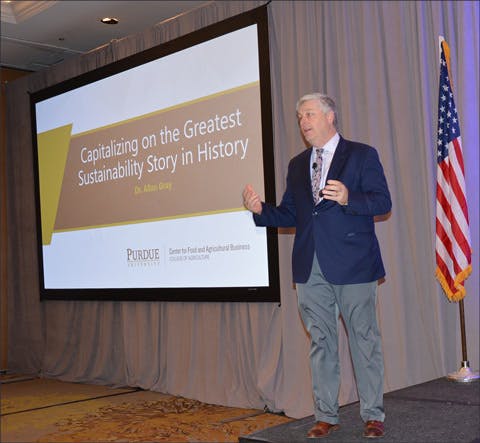Gray: Share Ag’s Sustainability Story, Focus on Why Meat is Best Choice
Those working in U.S. agriculture are part of the greatest sustainability story in history – but preserving that story and moving it forward will require producers and others in the industry to embrace change and technology to compete in the future.

Allan Gray of Purdue Univeristy presents “Capitalizing on the Greatest Sustainability story in History” at the opening general session of the USMEF Strategic Planning Conference
This according to Allan Gray, a professor at Purdue University and director of the school’s Center for Food and Agricultural Business. Gray delivered the keynote address, “Capitalizing on the Greatest Sustainability Story in History,” at the opening general session of the USMEF Strategic Planning Conference in Tucson, Arizona.
Gray’s message: share the sustainability story, meet the challenge posed by alternative proteins by focusing on why red meat is the best choice for consumers and accept that technology’s time has arrived on the farm, in the packing plant and at the supermarket meat counter.
“What we have known as the main elements of food productivity – inputs such as land, water and capital – are not enough to explain agriculture as the greatest sustainability story in the world,” Gray told the audience. “What is the explanation? It is technology. And if we want agriculture to continue to be the greatest sustainability story, we’ve got to know where technology is leading us.”
Gray explained that U.S. agricultural output has increased more than 250 percent over the past 70 years, while inputs have increased less than 10 percent.
“The three major inputs of the U.S. agriculture industry have all been declining, while agricultural production continues to increase,” he said. “With the help of technology, we are doing much more with much less – and that is the definition of sustainability. You must tell this story.”
Gray added that U.S. agriculture must challenge itself to move forward by adapting to change and use technology to create value, both at the consumer level and farm level. He noted that more than 100 technology companies offer products that are changing what is happening on farms – up and coming products that range from robotics that handle farm labor more efficiently than humans to digital systems that could help resolve industry-wide issues such as traceability for livestock producers and red meat exporters.
Gray offered his take on blockchain technology, admitting that, while few understand how the concept works, its potential is unmistakable.
“Blockchain could enable the entire food industry to work together in a trusted fashion,” he explained. “It’s a clean and clear way to get all of the things we need – productivity and traceability, for example – done in an efficient and transparent manner.”
Dismissing blockchain and other emerging concepts would be a mistake, he added.
“Technology, marketing and management of our businesses are changing and there’s an unprecedented drive for productivity, efficiency and sustainability," Gray said. “If we don’t understand this, we run the risk of being left behind. We must keep our heads up and pay attention.
Gray explained that the worst thing a livestock producer or grain farmer could do today is mimic industries that stayed put by claiming, “I don’t look up, I don’t look down. I just do what I do.” He shared the example of Blackberry as a company that “kept its head down and didn’t pay attention” as Apple developed and improved its iPhone, which now dominates the market.
Citing developments closer to the heart of the red meat industry, Gray said heavy investment has been made in online shopping and delivery services in the retail grocery sector. Major supermarket chains are in danger of being left behind if they ignore the trend toward e-commerce.
On the topic of alternative proteins, Gray said his advice to the meat industry would be to compete for consumers by helping people understand why traditional meat is the best choice.
“We all like choices, so the urge to take away alternative proteins as a choice may not be the best strategy,” he said. “Consumer preferences are very strong. So what we should be saying to them is, ‘you have choices, but our product is the best choice and here is why.’ Remind them of where meat comes from, because today’s consumer wants to know. Where does it come from? Your story is a good story, so share it.”
